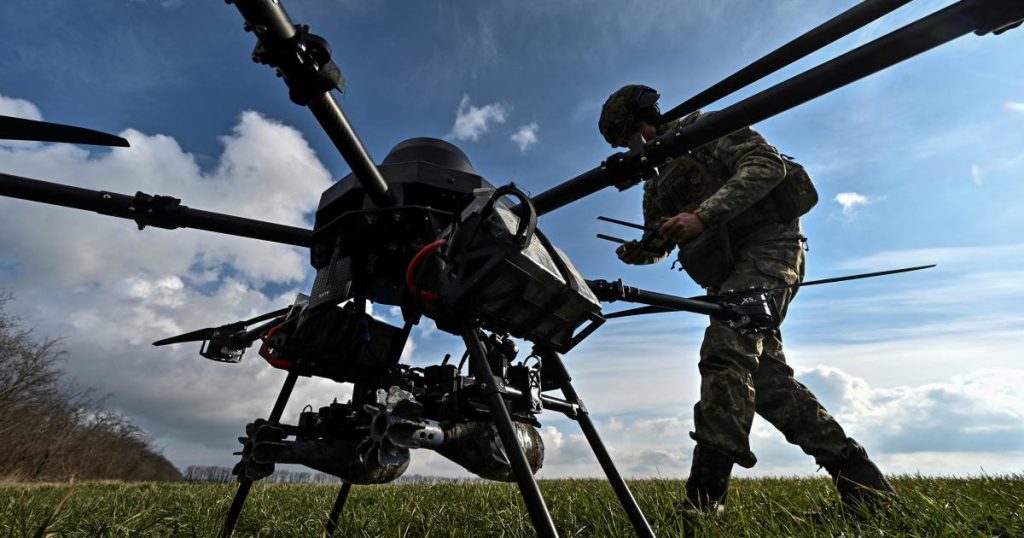
Very few people predicted that a long, high-intensity war in Europe was possible in the twenty-first century. But for three bloody years, Russia’s invasion of Ukraine has delivered exactly that. Hundreds of thousands of Russians and Ukrainians have died in the fighting. Many more have been injured. Entire towns have been reduced to ruin or cut apart by trenches, in a grim callback to World War I.
Now, the war in Ukraine has reached an apparent stasis. Russia continues to take small parcels of territory along the eastern front, but only by incurring unsustainably high casualties. The two countries have achieved parity when it comes to their long-range strike capabilities. Both have become fully mobilized war nations, allowing Russia to bounce back from its initial failures and allowing Ukraine, a smaller country, to keep fighting on through grievous losses. In the immediate future, then, the frontlines are likely to remain relatively stagnant. There will be no major breakthroughs.
U.S. President Donald Trump, however, has promised to end the war, reaching out to Moscow and setting up negotiations between American and Russian officials. In theory, these talks could turn 2025 into a decisive year for conflict. But there is no reason to think that interventions by Washington’s new sheriff will prove transformative, especially given that Kyiv has been frozen out of the conversation. The Trump administration is already discovering that the complexities of this conflict will preclude quick solutions. Trump has acceded to Russian President Vladimir Putin’s demand that Ukraine be locked out of NATO and Russia granted a sphere of influence. But Putin has given nothing in return, retaining his maximalist demands about Ukrainian disarmament and subjugation. The result could lead Washington to walk away and resume support for Kyiv.
But regardless of the outcome of the negotiations, the war in Ukraine has already changed the nature of conflict around the world. It has proven that today, drones, AI, and other kinds of advanced technology are important arbiters of success on the ground and in the air. It has demonstrated that warring countries are accelerating the pace of their battlefield and strategic adaptation. And it has highlighted the tensions between soldiers and civilians—and the weaknesses in current theories of how the two interact in high-tech conflict. In doing all of this, the war has exposed the shortfalls of Western militaries.
There are few certainties about how the invasion will play out, especially given Trump’s desire to force a resolution. But Putin will almost certainly continue to try to seize or destroy as much of Ukraine as possible in advance of any peace deal. (With a buildup of Russian troops in Belarus, he is clearly preparing to threaten other European countries, too.) Ukraine, meanwhile, is contemplating whether it can fight on without American help. Ukrainian President Volodymyr Zelensky recently pegged those odds as “low.” Yet if the Putin-Trump deal is intolerable to the government and people of Ukraine, the country will have to.
ADAPT OR PERISH
The conflict between Russia and Ukraine has changed much about how politicians, strategists, and civilian populations understand war. But one shift is especially obvious: autonomous and remotely operated vehicles have become a mandatory component of armies, navies, and air forces. Across the ground, maritime, and aerial domains, drones are being integrated into both the Russian and the Ukrainian militaries at remarkable speed. The number of aerial drones used in the war has expanded from hundreds to thousands to hundreds of thousands. Russia and Ukraine now each have the capacity to build millions of drones every year.
Both countries have been innovative in their use of drones. On the ground, each is pioneering new approaches to old missions by using drones for surveillance, logistical support, evacuating injured troops, laying and clearing mines, and, of course, launching attacks. But the Ukrainians have been extraordinarily creative. In the maritime domain, Ukraine defeated the Russian Black Sea Fleet with a variety of domestically designed semisubmersible, remotely operated vehicles. More recently, the country has pioneered coupling different drone systems for specific missions. In late 2024, Ukraine used maritime drones as launch pads for aerial drones to attack Russian oil rigs and surveillance systems in the Black Sea. In December, Ukraine paired ground and aerial systems in the battle for the village of Lyptsi, near Kharkiv, in which robotic weapons alone attacked and seized a fortified Russian defensive position for the first time, forcing the infantry manning it to retreat. And in January, the Ukrainians again launched aerial drones from maritime drones to attack Russian air defenses in occupied Kherson.
Unmanned vehicles will remain critical to how Ukraine keeps up with the Russians. In part through its use of drones, over the past three years Ukraine has built a long-range strike complex that now operates in parity with the Russian system. Kyiv is adapting and improving its strike capacity faster than Moscow is. As a result, Ukraine’s campaign against energy, military, and defense-industry targets is likely to hurt Russia more in 2025 than it has in the preceding three years. But in the future, both Ukraine and Russia are likely to more closely integrate humans and drones in military units. This will drive further innovation in human-drone tactics and will require new kinds of training for soldiers and military leaders.
The changes in Ukraine will affect every military institution in the coming decade.
The tentacles of technological insertions reach even further than drones. They have enabled the meshing of artificial intelligence, civil and military sensor networks, and the democratization of battlefield information. AI systems can help drones pick and confirm targets by combing through open-source sensors and intelligence analyses and then combining this information with military intelligence. These new technologies have also driven other, new ways of thinking about military tactics and structures. Just as drones will force the restructuring of existing military organizations and lead to the formation of new ones, AI will fundamentally change how officials make battlefield and strategic decisions. Although current algorithms must be improved to reduce hallucinations—when an AI delivers false or misleading information—and gain more trust from military commanders, AI systems are improving. The Israel Defense Forces have recently demonstrated the utility of AI support for target assessment, weapon selection and speeding up human decision-making.
New technology has led to adaptation. AI, for example, has helped both Russia and Ukraine close the time between when an enemy target is detected and when it can be attacked. The Ukrainians initially led the way with closing this “detection to destruction gap,” but Russia has caught up. Such innovation is not in itself surprising: learning and adaptation has always been part of warfare. But the pace is quickening. Consider that it took years for the U.S. military to adapt to the physical and intellectual demands of counterinsurgency operations in Afghanistan and Iraq a couple of decades ago but only months for Ukraine to develop its maritime drone strike fleet. Ukraine now updates some of its algorithms and drone communications software daily. And the learning and adaptation battle between Russia and Ukraine is continuing to accelerate as each side improves its ability to learn and share lessons between the battlefield and its national industrial bases. In doing so, these countries are underscoring an old truth: the military institutions that win wars are never the same organizations that begin them. Armed forces that can systemically and strategically adapt will have greater power in both war and peace.
The changes in Ukraine will affect every military institution in the coming decade. Western countries, in particular, will face a reckoning about their military postures. They do so just as Trump and his administration are calling old alliances into question, creating even more uncertainty and demanding a massive realignment of military structures in Europe and the Pacific.
CITIZEN SOLDIERS
Technology is essential to conflict. But war is not primarily a technological—or even really a military—undertaking. It is a human and societal endeavor. And just as drones have reshaped the battlefield, so have evolving civil-military dynamics. Modern technologies are now allowing private citizens to see many more aspects of the war than they could before, almost in real time. Commercial satellite imagery, for example, is now widely available. Through social media, citizens can review drone footage taken by soldiers of what’s happening on the battlefield on their cellphones, right after it was taken. A growing number of social media and other open-source analysts, using this easily accessible information, are adding their own evaluations of the war (admittedly of varying quality) to insights from news organizations, military institutions, and governments. As a result, ordinary people are now more exposed to and informed about war than ever before.
This increased exposure allows for even further citizen participation in war. Previously, noncombatants who wanted to participate mostly did so by raising war bonds. Now, private citizens are taking advantage of the Internet to directly raise funds or procure war material—including socks, first-aid kits, drones, and satellites—on an unprecedented scale. (There are entire nonprofits, for example, dedicated to raising money online for Ukrainian soldiers and units.) Citizens can also play an active role in reporting threats. Ukrainians, for instance, have created smartphone apps for reporting sightings of enemy units, drones, or missiles, and the information is then sent on to military forces.
Big-data warfare is, of course, a double-edged sword. Online information, artificial intelligence, social media, smart devices, and new analytical capabilities are making a once unimaginable amount of data available to each side’s adversaries, not only their supporters. That flood of information has, accordingly, permitted Russia and Ukraine to better target populations with propaganda. Kyiv, for example, has been messaging African and South Asian countries about the importance of their grain exports through the Black Sea, with the aim of decreasing support for Russia. Moscow has recently been seeking to dissuade those thinking about volunteering for Ukraine’s armed forces, including by spreading information about military corruption. Sometimes, this information also leads to societal trauma, with Russians and Ukrainians living far from the frontlines inundated with graphic and upsetting content about what’s happening to their forces.
There is certainly no shortage of such material. The scale of losses from the war in Ukraine is staggering. The conflict is a bitter and destructive struggle on the ground—to the point that it resembles the eastern front battles of World War II. In a February 2025 interview, Zelensky said that 45,000 Ukrainian soldiers have been killed and nearly 400,000 wounded since 2022. British intelligence has reported that over 850,000 Russian soldiers have been killed or wounded. The casualty rates, particularly on the Russian side, reached new heights in 2024, with Russia suffering more losses last year than in the previous two years combined.
The war in Ukraine has also reaffirmed the importance of good leadership.
Neither country can sustain high casualties forever. But each side has its own advantages in navigating the next phase of fighting. For Ukraine, it is ratios: the country is killing far more Russians than Russia is killing Ukrainians. As a result, Moscow’s advance is likely to slow in the coming months, even if Russia continues taking little tracts of land (a strategy that can be described as “bite and hold.”) If Ukraine can further skew the casualty ratio in its favor, as it did over the course of 2024, Russia’s offensive may culminate. This however does not mean that Ukraine would be ready for any major offensives, given its manpower challenges. A period of continued stasis, possibly with lower casualties, might then prevail until one side or the other reconstitutes its offensive potential.
But Ukraine has far fewer people than Russia. Many of its residents have fled the country. It can therefore afford to lose fewer troops. Moscow is also simply more tolerant of casualties than Kyiv, shocking even Ukraine’s own military leadership. Ukrainians are willing to make great sacrifice. But unlike the Kremlin, Kyiv is bothered by the idea of losing thousands upon thousands of troops for the foreseeable future.
The enormous casualties also have important implications for the wider world. At the close of the Cold War, many people believed that the era of large conventional wars had come to an end. National security leaders across the world downsized their countries’ military forces, munition stocks, and production capacity.
The situation in Ukraine has shown that such optimism was misguided. As a result, other countries have to increase both the size of their militaries and their ability to provide for them. Western states will have to remember, in particular, how to mobilize for large-scale warfare. Since the end of the Cold War, these countries have relied almost exclusively on all-volunteer forces. But the war in Ukraine has shown that such models—although politically popular and financially easier—are insufficient. They yield too few recruits given the increased variety of external threats. An evolved model is required, one that retains a professional all-volunteer force but complements it with a much larger mobilization pool through new national service and reserve schemes.
READY OR NOT
To be sure, the war in Ukraine has not upended everything analysts know about war. In fact, some of the laws of conflict have remained stolidly consistent. The past three years, for instance, have demonstrated that the element of surprise remains an integral part of war. Ukraine’s offensives in Kherson and Kharkiv in 2022 proved successful, in large part, because they caught Moscow off-guard. The offensives also demonstrated that, for all the recent technological innovations, the modern battlefield remains far from transparent. Humans will always seek advantage over their enemies through surprise and by exploiting the resulting shock.
The war in Ukraine has also reaffirmed the importance of good leadership. Zelensky’s decision early in the war to remain in Kyiv and lead his country not only confounded Putin and many Western leaders; it unified the Ukrainian people and has provided solid, dependable leadership. Likewise, Ukrainian battlefield commanders, although not without failures, have been more competent and considerate of the lives of soldiers than have Russia’s. Such courage, audacity, and will in political leaders are essential to successful warfare.
Unfortunately, since the end of the Cold War, the political classes in both the United States and Europe have lost sight of how important excellent leadership is to military preparedness. They were, after all, nearly unified in deciding to downsize militaries and defense industrial complexes. Since the invasion of Ukraine, some of these politicians have called for course corrections. But much of the Western political class remains unwilling to speak openly about the profound security challenges posed by China and Russia. The risks that stem from this silence cannot be overstated. The development of excellent battlefield leaders is crucial to success in war, but the best tactical leaders in the world can accomplish nothing if their country has a bad strategy or no strategy—or otherwise lacks the will to fight for what it believes. Wars, after all, are demonstrations of human will, not just of tactical acumen.
Wars are mass tragedies, as tens of millions of Ukrainians can now attest. Yet out of the suffering and heartbreak of soldiers and civilians can arise many educational opportunities. Since Russia began its large-scale invasion, Europe has seen more violence, destruction, and calamity than it has since 1945. But the continent and its allies have also learned critical facts about war, strategy, leadership, civil defense, economics, and military affairs (which, of course, are equally available to their adversaries).
The sacrifices of the Ukrainian people have more than earned them the right to live free of Russian subjugation and influence and to celebrate their history and culture. But achieving those aims will require continued American and European support in the year ahead. Ukraine has made impressive strides in developing its own defense industry, producing as much as 40 percent of its requirements. Yet that still leaves large holes its partners must fill. One hopes that Western political leaders will have the moral courage and intellectual capacity to honor Ukraine’s sacrifices by giving Kyiv what it needs to keep fighting—and to strengthen their own armed forces to resist ongoing authoritarian aggression.
Loading…







